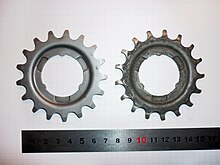
Back اهتراء Arabic Trošenje BS Desgast Catalan Opotřebení Czech Verschleiß German Desgaste Spanish Kulumine Estonian Higadura (mekanika) Basque سایش Persian Kuluminen Finnish

Wear is the damaging, gradual removal or deformation of material at solid surfaces. Causes of wear can be mechanical (e.g., erosion) or chemical (e.g., corrosion). The study of wear and related processes is referred to as tribology.
Wear in machine elements, together with other processes such as fatigue and creep, causes functional surfaces to degrade, eventually leading to material failure or loss of functionality. Thus, wear has large economic relevance as first outlined in the Jost Report.[1] Abrasive wear alone has been estimated to cost 1–4% of the gross national product of industrialized nations.[2]
Wear of metals occurs by plastic displacement of surface and near-surface material and by detachment of particles that form wear debris. The particle size may vary from millimeters to nanometers.[3] This process may occur by contact with other metals, nonmetallic solids, flowing liquids, solid particles or liquid droplets entrained in flowing gasses.[4]
The wear rate is affected by factors such as type of loading (e.g., impact, static, dynamic), type of motion (e.g., sliding, rolling), temperature, and lubrication, in particular by the process of deposition and wearing out of the boundary lubrication layer.[5] Depending on the tribosystem, different wear types and wear mechanisms can be observed.
- ^ Cite error: The named reference
:0was invoked but never defined (see the help page). - ^ Davis, J. R. (2001). Surface engineering for corrosion and wear resistance. ASM International. p. 56. ISBN 0-87170-700-4. OCLC 1027005806.
- ^ Akchurin, Aydar; Bosman, Rob; Lugt, Piet M.; Drogen, Mark van (2016-06-16). "Analysis of Wear Particles Formed in Boundary-Lubricated Sliding Contacts". Tribology Letters. 63 (2): 16. doi:10.1007/s11249-016-0701-z. ISSN 1023-8883.
- ^ Davis, J.R., ed. (1998). Metals Handbook: Desk Edition. ASM International. ISBN 9780871706546.
- ^ Popov, Valentin L. (2018). "Is Tribology Approaching Its Golden Age? Grand Challenges in Engineering Education and Tribological Research". Frontiers in Mechanical Engineering. 4. doi:10.3389/fmech.2018.00016.
© MMXXIII Rich X Search. We shall prevail. All rights reserved. Rich X Search